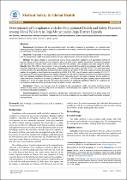| dc.description.abstract | Background: Compliance with the occupational health and safety measures at workplace is an important step
towards providing a healthier welding workplace; especially in developing countries like Uganda where such measures
are commonly not well-considered.
Objective: The purpose of this study was to assess the work environment and individual determinants of compliance
with the occupational health and safety practices among metal welders in Jinja municipality-Jinja district.
Method: The study adopted a cross-sectional survey design using both qualitative and quantitative method of
enquiry. Simple random sampling and convenience sampling were used to assess the welders. Structured interviews
and key informant interview were used to obtain data from the welders. Data analysis was done using the SPSS.
Results: Only 50% (120) of the welders in Jinja municipality complied with the welding occupational health and safety
practices. Regularly checking and maintenance of welding plant and equipment (p=0.000, X2=33.771), supervisor often
remind workers of the potential risks and hazards in their workplace (p=0.000, X2=48.614), supervisor always consulting
welders for suggestions about how to improve safety (p=0.004, X2=8.103), type of material used for welding (X2=10.112,
p=0.006) and the number of employees per welding enterprise (X2=18.898, 0.008) were the work environment conditions
that had statistical significant influence on compliance to occupation health and safety practices among welders in
Jinja municipality. Duration in the welding profession (X2=8.654, p=0.034) and thought of getting injured easily while
welding (X2 = 8.515, p=0.004) were the individual factors that have a statistically significant influence on compliance to
occupational health and safety practices among the welders in Jinja municipality.
Conclusion: There is an average level of compliance with occupational health and safety practices among
welders in Jinja district. Basically only half of the welders in the Municipality are compliant mainly due to welding work
environment characteristics/factors.
Recommendations: Orientation, awareness, development of standard rules, enforcement of the safety codes and
conducts were the recommendations necessary to improve the compliance to occupational health and safety practices
among welders. | en_US |

